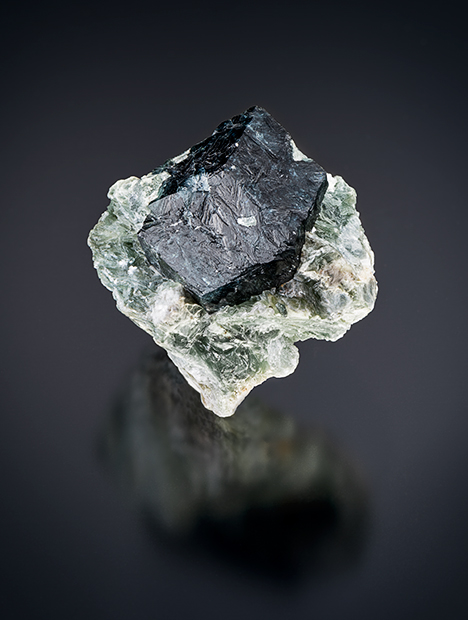Blue Dravite-Uvite Tourmaline from Koksha Valley, Afghanistan

Tourmaline is popular among gem and mineral enthusiasts for its extensive variety of colors. Blue, one of the most sought-after hues, is usually encountered as elbaite, a sodium- and lithium-containing species with the chemical formula Na(Li1.5Al1.5)Al6(Si6O18)(BO3)3(OH)3(OH). While it has been reported that very limited quantities of dark blue tourmaline crystals are being mined in Afghanistan’s Koksha Valley, we have found that this material appears to be a hybrid species of dravite-uvite tourmaline (figure 1).
Around a dozen blue crystals in pale green and brown micaceous matrix first surfaced in the gem markets of Peshawar, Pakistan, in late 2009, as confirmed by two sources (S. Khan and P. Slootweg, pers. comms., 2016). These crystals, reportedly from Badakhshan Province’s Koksha Valley, were subsequently assumed to be a member of the tourmaline group based on their ditrigonal pyramidal habit. Since that time, only very small batches of these crystals have turned up; interestingly, a few of these specimens have been associated with sapphire in the same matrix (P. Slootweg, pers. comm., 2016). In 2010, while examining sapphire rough believed to be from a deposit near the Koksha Valley, GIA’s Bangkok laboratory identified bluish green crystals present in some matrix specimens of sapphire as dravite tourmaline (Spring 2011 Lab Notes, pp. 53–54). While the Koksha Valley is most famous for extensive deposits of high-quality lapis lazuli near Sar-e-Sang, sapphire mining takes place near the village of Hazrat Saeed, 25 km north of Sar-e-Sang along the Koksha River (T.P. Moore and R.W.M. Woodside, “The Sar-e-Sang lapis mine,” Mineralogical Record, Vol. 45, No. 3, 2014, pp. 280–336). The sapphire at Hazrat Saeed is recovered from mica-rich gneiss, and it appears that these green and blue tourmalines were uncovered as a by-product of sapphire mining operations.
Laser ablation–inductively coupled plasma–mass spectrometry (LA-ICP-MS) was used to analyze the chemical composition of the dark blue tourmaline seen in figure 1. Three spots were measured and plotted (figure 2). Two of the spots showed that the tourmaline contained dravite; the third revealed the presence of uvite (D.J. Henry et al., “Nomenclature of the tourmaline-supergroup minerals,” American Mineralogist, Vol. 96, No. 5–6, 2011, pp. 895–913). Dravite, NaMg3Al6(Si6O18)(BO3)3(OH)3OH, is a sodium- and magnesium-rich tourmaline typically encountered in brown, yellow, black, and rarely as intense green. Uvite, Ca(Mg3)MgAl5(Si6O18)(BO3)3(OH)3(F/OH), is a calcium- and magnesium-rich tourmaline that is often brown, green, or deep red. Our analysis suggests that this blue tourmaline specimen is composed of a mixture of dravite and uvite. While fibrous blue dravite has been reported in the Czech Republic (M. Novak, “Blue dravite as an indicator of fluid composition during subsolidus replacement processes in Li-poor granitic pegmatites in the Moldanubicum, Czech Republic,” Journal of the Czech Geological Society, Vol. 43, No. 1–2, 1998, pp. 24–30), this is the first large single-crystal blue dravite-uvite tourmaline the authors have encountered.

.jpg)


